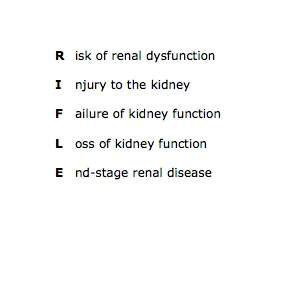A study that assessed the predictive value of the Risk of renal dysfunction, Injury to the kidney, Failure of kidney function, Loss of kidney function and End-stage renal disease (RIFLE) urine output criteria on contrast-induced nephropathy in critically ill patients found its predictive value to be low, which limits its use for assessing the effects of therapeutic interventions on AKI. The paper is published in BMC Nephrology.
In their study, Aldjia Hocine and colleagues from CHU-Charleroi, Université Libre de Bruxelles in Belgium, reviewed the cases of 149 patients in the CHU-Charleroi 24-bed medical-surgical ICU who received intra-arterial or intra-venous contrast media (CM) for a CT scan or coronary angiography in a 3-year period. Of the 149 patients aged over 18 and who stayed minimum 3 days in the ICU after the CM infection, 98 received contrast media for CT and 51 for coronary angiography. Daily serum creatinine concentrations and diuresis were measured for 3 days after the injection of CM. No protocol for contrast-associated acute kidney injury (CA-AKI) prevention was applied routinely in the ICU during the study period - only 19.5 % of the patients who developed CA-AKI received preventive therapy.
See Also: An Update From The Contrast Media Safety Committee of the European Society of Urogenital Radiology
The researchers conclude that the predictive value of RIFLE urine output criteria for the development of CA-AKI based on creatinine concentrations was low, which limits its use for assessing the effects of therapeutic interventions on the development and progression of AKI.
In their study, Aldjia Hocine and colleagues from CHU-Charleroi, Université Libre de Bruxelles in Belgium, reviewed the cases of 149 patients in the CHU-Charleroi 24-bed medical-surgical ICU who received intra-arterial or intra-venous contrast media (CM) for a CT scan or coronary angiography in a 3-year period. Of the 149 patients aged over 18 and who stayed minimum 3 days in the ICU after the CM infection, 98 received contrast media for CT and 51 for coronary angiography. Daily serum creatinine concentrations and diuresis were measured for 3 days after the injection of CM. No protocol for contrast-associated acute kidney injury (CA-AKI) prevention was applied routinely in the ICU during the study period - only 19.5 % of the patients who developed CA-AKI received preventive therapy.
See Also: An Update From The Contrast Media Safety Committee of the European Society of Urogenital Radiology
Results
23 cases of contrast-associated acute kidney injury (CA-AKI) were identified (15.4%). The cases were identified according to the definition proposed by Barrett and Parfrey, namely increase in serum creatinine by 25% from baseline or a minimum of 0.5 mg/dL within 3 days after CM administration. The CA-AKI patients were more likely to require renal replacement therapy and had higher ICU mortality rates. At least one RIFLE urine output criteria was observed in 45 patients (30.2%), and 14 of these 45 patients (31.1 %) developed CA-AKI based on creatinine concentrations. In 30% of these cases, urine output decreased or didn’t change after the increase in creatinine concentrations. The RIFLE urine output criteria had low sensitivity (39.1 %) and specificity (67.9 %) for prediction of CA-AKI, a low positive predictive value of 50 % and a negative predictive value of 87.2 %. The maximal dose of vasopressors before CM was the only independent predictive factor for CA-AKI.The researchers conclude that the predictive value of RIFLE urine output criteria for the development of CA-AKI based on creatinine concentrations was low, which limits its use for assessing the effects of therapeutic interventions on the development and progression of AKI.
References:
Hocine A, Defrance P, Lalmand J, Delcour C, Biston P, Piagnerelli M
(2016) Predictive value of the RIFLE urine output criteria on contrast-induced nephropathy in critically ill patients. BMC Nephrol.
2016 Mar 28;17:36. doi: 10.1186/s12882-016-0243-5.
Latest Articles
acute kidney injury, contrast media
A study that assessed the predictive value of the Risk of renal dysfunction, Injury to the kidney, Failure of kidney function, Loss of kidney function and End-stage renal disease (RIFLE) urine output criteria on contrast-induced nephropathy in critically










